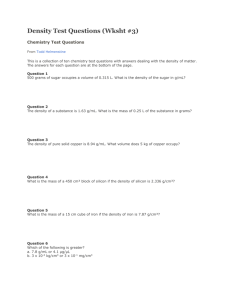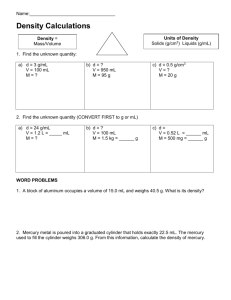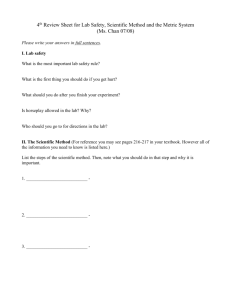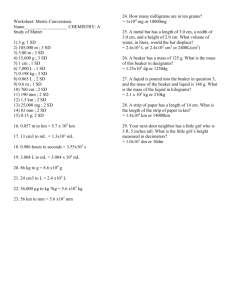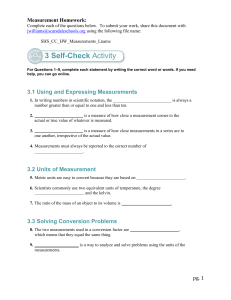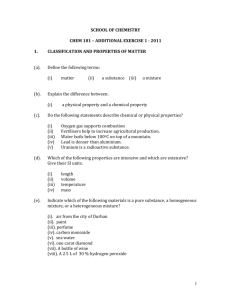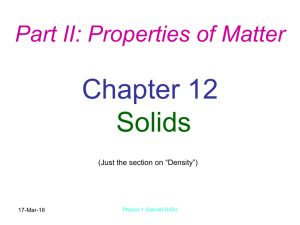density word problems 09
advertisement
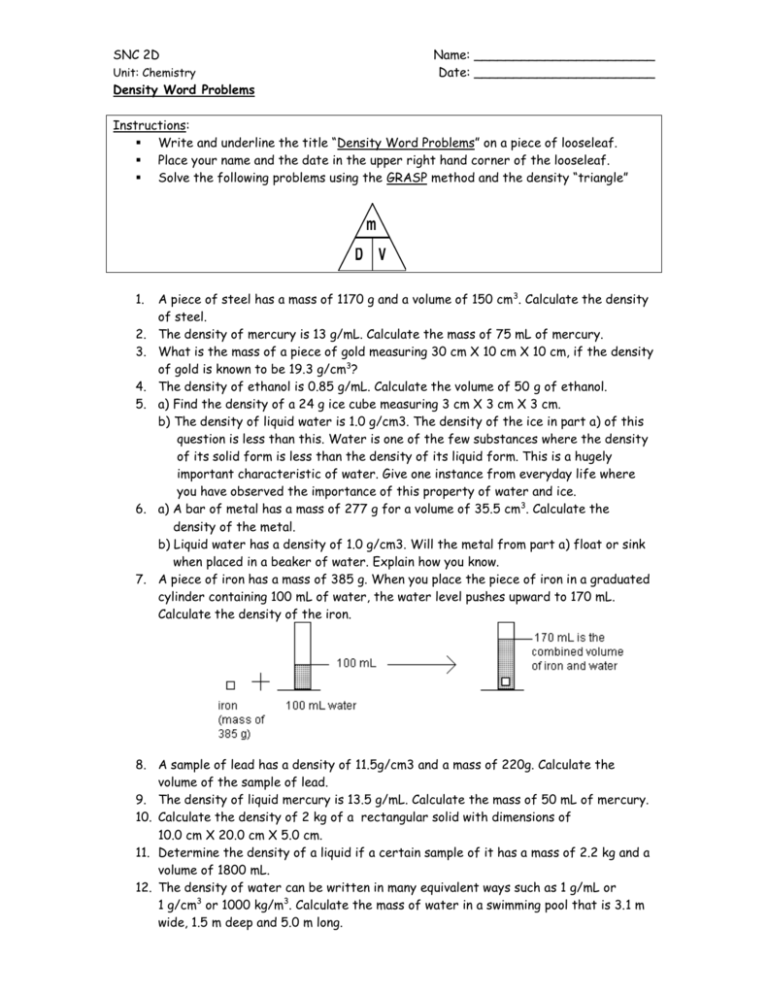
SNC 2D Name: _______________________ Date: _______________________ Unit: Chemistry Density Word Problems Instructions: Write and underline the title “Density Word Problems” on a piece of looseleaf. Place your name and the date in the upper right hand corner of the looseleaf. Solve the following problems using the GRASP method and the density “triangle” m D V 1. 2. 3. 4. 5. 6. 7. A piece of steel has a mass of 1170 g and a volume of 150 cm 3. Calculate the density of steel. The density of mercury is 13 g/mL. Calculate the mass of 75 mL of mercury. What is the mass of a piece of gold measuring 30 cm X 10 cm X 10 cm, if the density of gold is known to be 19.3 g/cm3? The density of ethanol is 0.85 g/mL. Calculate the volume of 50 g of ethanol. a) Find the density of a 24 g ice cube measuring 3 cm X 3 cm X 3 cm. b) The density of liquid water is 1.0 g/cm3. The density of the ice in part a) of this question is less than this. Water is one of the few substances where the density of its solid form is less than the density of its liquid form. This is a hugely important characteristic of water. Give one instance from everyday life where you have observed the importance of this property of water and ice. a) A bar of metal has a mass of 277 g for a volume of 35.5 cm3. Calculate the density of the metal. b) Liquid water has a density of 1.0 g/cm3. Will the metal from part a) float or sink when placed in a beaker of water. Explain how you know. A piece of iron has a mass of 385 g. When you place the piece of iron in a graduated cylinder containing 100 mL of water, the water level pushes upward to 170 mL. Calculate the density of the iron. 8. A sample of lead has a density of 11.5g/cm3 and a mass of 220g. Calculate the volume of the sample of lead. 9. The density of liquid mercury is 13.5 g/mL. Calculate the mass of 50 mL of mercury. 10. Calculate the density of 2 kg of a rectangular solid with dimensions of 10.0 cm X 20.0 cm X 5.0 cm. 11. Determine the density of a liquid if a certain sample of it has a mass of 2.2 kg and a volume of 1800 mL. 12. The density of water can be written in many equivalent ways such as 1 g/mL or 1 g/cm3 or 1000 kg/m3. Calculate the mass of water in a swimming pool that is 3.1 m wide, 1.5 m deep and 5.0 m long. SNC 1D Chemistry Unit Name: _____________________ Date: _____________________ Interpreting Mass versus Volume Graphs 1. The masses and volumes of different samples of two substances – substance X and substance Y – were plotted on the graph on the back of this page. The unit for mass in this instance is kilograms, kg. The unit for volume is cubic metres, m 3. The graph is incomplete. Complete it. 2. Two of the data points for substance X are not on the line of best fit that has been drawn. Why is this? 3. Use the graph to predict the mass for each of the following volumes. a) 0.25 m3 of substance X has a mass of ____________________ . b) 0.80 m3 of substance Y has a mass of ____________________ . 4. Use the graph to predict the volumes for each of the following masses. a) 450 kg of substance X will have a mass of ___________________ . b) 500 kg of substance Y will have a mass of ___________________ . 5. Fill in the following table for points A and B on the line for substance X. Mass (kg) Volume (m3) kg Density ( 3 ) m Substance X at point A Substance X at point B 6. Based on your results from #5 above, circle the word(s) in brackets to correctly complete the following statements. Statements: If a mass versus volume graph is plotted using data from samples of a substance, then most of the data will be on a (curve, line) of best fit. The mass ratio for volume any point on this line will be (the same as it is for all other values on the line; a value different from all other values on the line). This mass value is called volume (mass, volume, size, density). The density of a substance is a characteristic physical property so it is always (changing, the same) for that substance regardless of the mass or volume of any sample. 7. a) Would you expect the density of substance X to be larger or smaller than that for substance Y? _____________ Explain your answer. b) You calculated the density of substance X in #5. Now, calculate the density of substance Y to ensure your answer to 7a) is correct. c) If Substance X and Substance Y are both liquids, which one will sit on top of the other one if they are poured into the same beaker? _______________ How do you know?


